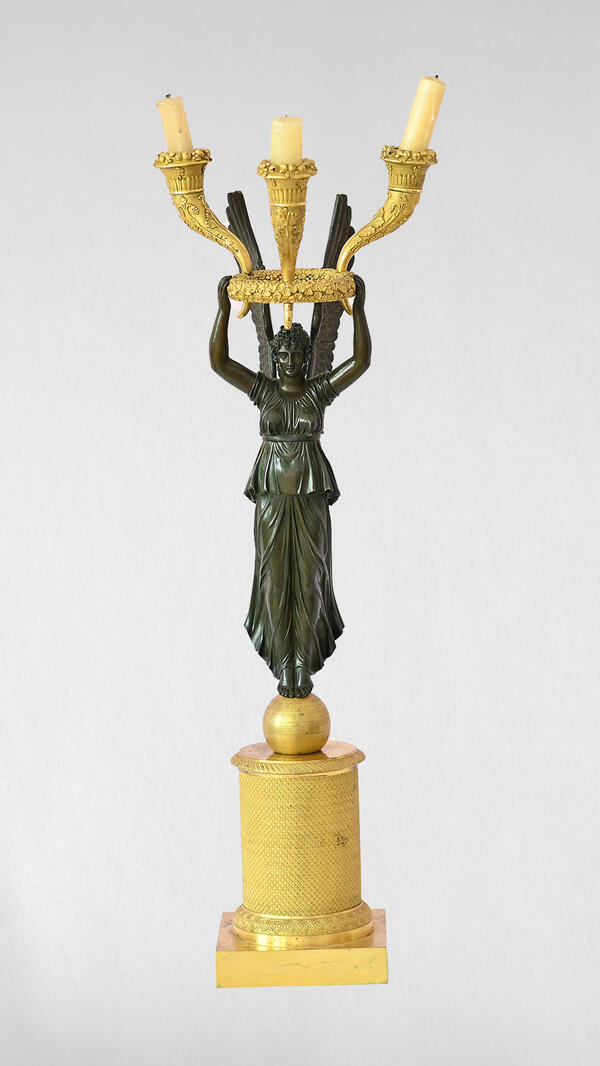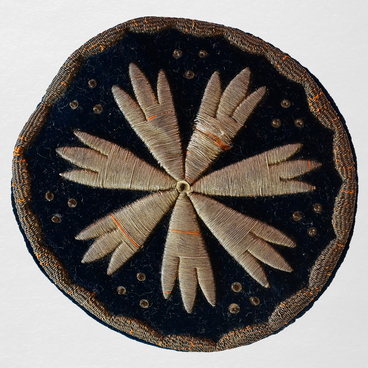An elegantly shaped candelabra depicting the Greek goddess Nike was transferred to the Tchaikovsky Museum Estate from the State Hermitage Museum in December 1968 during the preparation of a new exhibition in the memorial house to commemorate the composer’s 130th anniversary.
The candelabra is made of patinated bronze and depicts the winged Greek goddess Nike, who personified victory. Patina is a thin layer on the surface of copper and its alloys, produced by oxidation. Nike holds in her raised hands a wreath with three candle stands in the form of cornucopia, decorated with a foliage pattern. The goddess stands on a celestial sphere. A cylindrical gilded pedestal on top and on the bottom is trimmed with plated flower wreaths and decorated with parallel diagonal lines of continuous notches.
Unlike candlesticks, a candelabra serves as a stand for several candles and not for a single one. A candelabra with multiple arms arranged in a circle and decorated with crystal glass is called a “girandole”, and a floor candelabra is called a torchère.
The first wall, table, and floor metal candelabras were introduced to Russia from France. Until the 18th century, most candelabras were cast from silver, but later they were made of various ferrous metals or bronze. Such items were much cheaper than the silver ones and became affordable for less wealthy townspeople.
In the 18th and 19th centuries, special attention was paid to the decoration of candelabras. For example, Baroque-style items were decorated with maple leaves, small flowers, and other floral patterns. The classicist candlesticks imitated antique columns and statues. Most commonly, they were decorated with figures of mythological creatures or exotic animals, such as griffins, lions, dolphins, as well as with Gods or entire scenes from ancient Greek legends.
Traditionally, candelabras were displayed in showrooms often visited by guests: a hall, a reception room, or a living room. They were placed on special pedestals or decorative tables.
The candelabra is made of patinated bronze and depicts the winged Greek goddess Nike, who personified victory. Patina is a thin layer on the surface of copper and its alloys, produced by oxidation. Nike holds in her raised hands a wreath with three candle stands in the form of cornucopia, decorated with a foliage pattern. The goddess stands on a celestial sphere. A cylindrical gilded pedestal on top and on the bottom is trimmed with plated flower wreaths and decorated with parallel diagonal lines of continuous notches.
Unlike candlesticks, a candelabra serves as a stand for several candles and not for a single one. A candelabra with multiple arms arranged in a circle and decorated with crystal glass is called a “girandole”, and a floor candelabra is called a torchère.
The first wall, table, and floor metal candelabras were introduced to Russia from France. Until the 18th century, most candelabras were cast from silver, but later they were made of various ferrous metals or bronze. Such items were much cheaper than the silver ones and became affordable for less wealthy townspeople.
In the 18th and 19th centuries, special attention was paid to the decoration of candelabras. For example, Baroque-style items were decorated with maple leaves, small flowers, and other floral patterns. The classicist candlesticks imitated antique columns and statues. Most commonly, they were decorated with figures of mythological creatures or exotic animals, such as griffins, lions, dolphins, as well as with Gods or entire scenes from ancient Greek legends.
Traditionally, candelabras were displayed in showrooms often visited by guests: a hall, a reception room, or a living room. They were placed on special pedestals or decorative tables.



